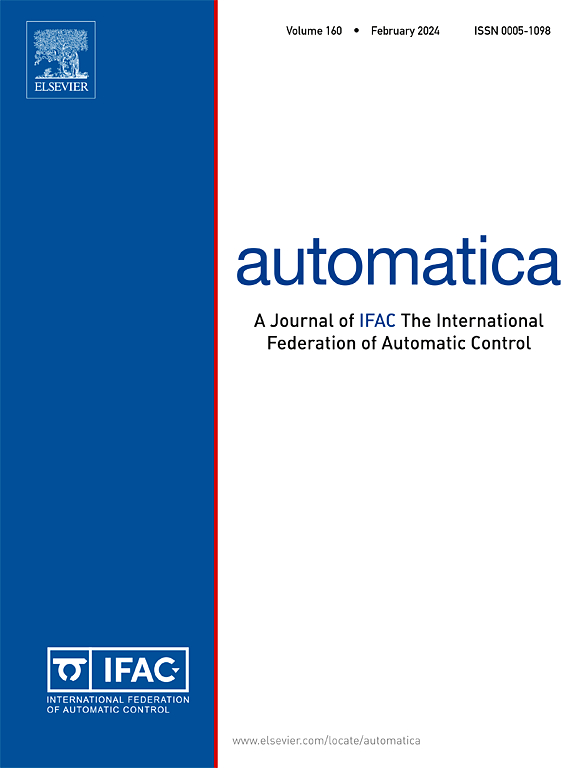利用稀疏估计降低非线性模型输入设计的计算复杂度
IF 5.9
2区 计算机科学
Q1 AUTOMATION & CONTROL SYSTEMS
引用次数: 0
摘要
输入的概率密度函数在识别非线性系统的过程中起着至关重要的作用,在此过程中通常采用有限表示。然而,非线性模型的输入设计是一项具有挑战性的任务,因为它通常涉及到优化具有大量自由变量的问题,这是计算量很大的。本文的第一个贡献是证明了这些自由变量的大多数为零。因此,没有必要对它们全部进行优化。第二个贡献是识别与输入设计相关的这组自由变量中的非零变量。为了解决这个问题,我们提出了一种交替最小化方法。在第一步中,我们计算每个样本的Fisher信息矩阵(FIM)。然后,在第二阶段,我们使用先前导出的逐样本FIM估计自由变量向量内非零元素的位置。此外,在后期,我们使用Karush-Kuhn-Tucker条件计算了优化问题中的拉格朗日乘子,并推导了超参数的上界,从而提高了稀疏性。这个边界确保了表示每个样本FIM所需的非零变量的最大数量。在此之后,将原始输入设计问题简化为仅针对非零元素优化成本函数,从而大大减少了计算时间。为了评估我们提出的方法的有效性,我们通过将其与最先进的输入设计算法进行比较,进行了全面的数值性能评估。本文章由计算机程序翻译,如有差异,请以英文原文为准。
Reducing computational complexity in nonlinear model input design via sparse estimation
The probability density function of the input plays a crucial role in the process of identifying nonlinear systems, with a finite representation commonly employed in the process. However, input design for nonlinear models is a challenging task because it usually involves optimizing a problem with a large number of free variables, which is computationally heavy. The first contribution of this paper is to demonstrate that the majority of these free variables are zero. Consequently, there is no necessity to optimize all of them. The second contribution is to identify the non-zero variables within this set of free variables associated with input design. To address this, we propose an alternating minimization approach. In the first step, we compute the per-sample Fisher Information Matrix (FIM). Then, in the second phase, we estimate the positions of the non-zero elements within the vector of free variables using the previously derived per-sample FIM. Additionally, in the later phase, we calculate the Lagrangian multipliers in our optimization problem using the Karush–Kuhn–Tucker conditions and derive an upper bound for the hyperparameter, which promotes sparsity. This bound ensures the maximum required number of non-zero variables to represent the per-sample FIM. Following this, the original input design problem is streamlined to optimize the cost function only with respect to the non-zero elements, resulting in a significant reduction in computational time. To assess the effectiveness of our proposed method, we conduct a comprehensive numerical performance evaluation by comparing it to state-of-the-art input design algorithms.
求助全文
通过发布文献求助,成功后即可免费获取论文全文。
去求助
来源期刊

Automatica
工程技术-工程:电子与电气
CiteScore
10.70
自引率
7.80%
发文量
617
审稿时长
5 months
期刊介绍:
Automatica is a leading archival publication in the field of systems and control. The field encompasses today a broad set of areas and topics, and is thriving not only within itself but also in terms of its impact on other fields, such as communications, computers, biology, energy and economics. Since its inception in 1963, Automatica has kept abreast with the evolution of the field over the years, and has emerged as a leading publication driving the trends in the field.
After being founded in 1963, Automatica became a journal of the International Federation of Automatic Control (IFAC) in 1969. It features a characteristic blend of theoretical and applied papers of archival, lasting value, reporting cutting edge research results by authors across the globe. It features articles in distinct categories, including regular, brief and survey papers, technical communiqués, correspondence items, as well as reviews on published books of interest to the readership. It occasionally publishes special issues on emerging new topics or established mature topics of interest to a broad audience.
Automatica solicits original high-quality contributions in all the categories listed above, and in all areas of systems and control interpreted in a broad sense and evolving constantly. They may be submitted directly to a subject editor or to the Editor-in-Chief if not sure about the subject area. Editorial procedures in place assure careful, fair, and prompt handling of all submitted articles. Accepted papers appear in the journal in the shortest time feasible given production time constraints.
 求助内容:
求助内容: 应助结果提醒方式:
应助结果提醒方式:


